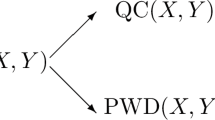Abstract
Scalable spaces are simply connected compact manifolds or finite complexes whose real cohomology algebra embeds in their algebra of (flat) differential forms. This is a rational homotopy invariant property and all scalable spaces are formal; indeed, scalability can be thought of as a metric version of formality. They are also characterized by particularly nice behavior from the point of view of quantitative homotopy theory. Among other results, we show that spaces which are formal but not scalable provide counterexamples to Gromov’s long-standing conjecture on distortion in higher homotopy groups.



Similar content being viewed by others
Notes
This is essentially the inverse function of the notion used in [12], but accords with the notion of distortion used in geometric group theory.
While the minimal model is unique up to isomorphism, such an isomorphism need not preserve this.
References
Berdnikov, A.: Lipschitz null-homotopy of mappings \(S^3 \rightarrow S^2\), arXiv preprint arXiv:1811.02606 (2018)
Chambers, G.R., Dotterrer, D., Manin, F., Weinberger, Sh.: Quantitative null-cobordism. J. Amer. Math. Soc. 31(4), 1165–1203 (2018)
Chambers, G.R., Manin, F., Weinberger, Sh.: Quantitative nullhomotopy and rational homotopy type. Geomet. Func. Anal. (GAFA) 28(3), 563–588 (2018)
Deligne, Pierre, Griffiths, Phillip, Morgan, John, Sullivan, Dennis: Real homotopy theory of Kähler manifolds. Invent. Math. 29(3), 245–274 (1975)
Federer, H.: Geometric measure theory, Die Grundlehren der mathematischen Wissenschaften, vol. 153, Springer, (1969)
Félix, Y., Halperin, S., Thomas, J.-C.: Rational homotopy theory, Graduate Texts in Mathematics, vol. 205, Springer, (2012)
Ferry, Steve, Weinberger, Shmuel: Quantitative algebraic topology and lipschitz homotopy. Proceed. Natl. Acad. Sci. 110(48), 19246–19250 (2013)
Gol’dshtein, V.M., Kuz’minov, V.I., Shvedov, I.A.: Differential forms on Lipschitz manifolds. Siberian Math. J. 23(2), 151–161 (1982)
Griffiths, Ph. A., Morgan, J. W.: Rational homotopy theory and differential forms, Birkhäuser, (1981)
Gromov, M.: Homotopical effects of dilatation. J. Differ. Geomet. 13(3), 303–310 (1978)
Gromov, M.: Metric structures for Riemannian and non-Riemannian spaces, Progress in Mathematics, vol. 152, Birkhäuser Boston, Inc., Boston, MA, 1999, with appendices by M. Katz, P. Pansu and S. Semmes, translated from the French by Sean Michael Bates
Gromov, M.: Quantitative homotopy theory, Prospects in mathematics (Princeton, NJ,: Amer. Math. Soc. Providence, RI 1999, 45–49 (1996)
Guth, L.: Recent progress in quantitative topology, Surveys in Differential Geometry,: Celebrating the 50th anniversary of the Journal of Differential Geometry, Surv. Differ. Geom., vol. 22. Int. Press, Somerville, MA 2018, 191–216 (2017)
Halperin, Stephen, Stasheff, James: Obstructions to homotopy equivalences. Adv. Math. 32(3), 233–279 (1979)
Kotschick, D.: On products of harmonic forms. Duke Math. J. 107(3), 521–531 (2001)
Manin, F.: Plato’s cave and differential forms. Geomet. Topol. 23(6), 3141–3202 (2019)
Manin, F.: A zoo of growth functions of mapping class sets. J. Topol. Anal. 12(3), 841–855 (2020)
Manin, F.: Positive weights and self-maps, Proc. Amer. Math. Soc. (to appear)
Manin, F., Weinberger, Sh.: Integral and rational mapping classes. Duke Math. J. 169(10), 1943–1969 (2020)
Shiga, H.: Rational homotopy type and self maps. J. Math. Soc. Japan 31(3), 427–434 (1979)
Sullivan, D.: Infinitesimal computations in topology. Inst. Hautes Études Sci. Publ. Math. 1977(47), 269–331 (1978)
Wenger, S.: Nilpotent groups without exactly polynomial Dehn function. J. Topol. 4(1), 141–160 (2011)
Whitney, Hassler: Geometric integration theory, Princeton Mathematical Series, vol. 21, Princeton University Press, (1957)
Acknowledgements
We would like to thank Robert Young, who pointed out the reference [22], as well as Robin Elliott and Shmuel Weinberger for other useful comments. We also thank the anonymous referee for a large number of corrections as well as clarifying questions and remarks which greatly improved the exposition and led us to several discoveries. The second author was supported by the NSF via the individual grant DMS-2001042.
Author information
Authors and Affiliations
Corresponding author
Additional information
Publisher's Note
Springer Nature remains neutral with regard to jurisdictional claims in published maps and institutional affiliations.
Rights and permissions
About this article
Cite this article
Berdnikov, A., Manin, F. Scalable spaces. Invent. math. 229, 1055–1100 (2022). https://doi.org/10.1007/s00222-022-01118-9
Received:
Accepted:
Published:
Issue Date:
DOI: https://doi.org/10.1007/s00222-022-01118-9




